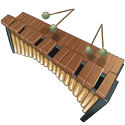|
webcams for christ posted:you could also combine your practice of learning note names / chord spellings with reading them on a staff. they have handy pens like this or this which would help save time.
|
|
|
|

|
| # ? May 3, 2024 06:06 |
|
Cimber posted:ok, I've found out something that is confusing the poo poo outta me. Screwing around on my piano when I was trying to figure out a chord name. Went down to my mac and typed those keys (E-G-A-C) out and it popped up as C6. Why wouldn't it be called A minor 7? It's all the keys for the Am7 just in an inversion? Is this garage band being strange in its naming, or is there some funky music theory thing i don't know yet. chords can have multiple names, especially chords with 4 or more tones. no need to figure out which name is best, your understanding of music theory will be enriched the more of them you can recognize! for example, it can be useful to know that Fmaj7 is Am/F, because maybe there are A minor licks that would sound interesting instead of the usual F major licks you might play by default. ditto for minor 7 / major 6 chords like the one you encountered.
|
|
|
|
Gotta say itís really cool when you start getting familiar enough with intervals, scales, keys, and modes to roughly bang out whatever cool melody or musical idea you heard in a song or track you like, with a minimum of confusion doubt and boneheaded mistakes. Things start making a bit more sense. Though TBQH Iím still not convinced that any insights I came to on my own are still significant, useful, or even true. I might think I have a knack for music, but Iím probably wrong and even if not thereís always someone with more knack out there. I still canít use more than one hand at a time on keys, after all.
|
|
|
|
Pollyanna posted:Though TBQH Iím still not convinced that any insights I came to on my own are still significant, useful, or even true. I might think I have a knack for music, but Iím probably wrong and even if not thereís always someone with more knack out there. I still canít use more than one hand at a time on keys, after all. This is why, contrary to popular belief, you should surround yourself with much worse musicians. You'll feel like a genius when you know the chord numbers and can count in to start a tune.
|
|
|
|
i hummed out a tune and found it was in E natural minor or g major. i kept playing my riffs from c so i been using g phyrgian as my anchor point when i want to feel a bit naughty i hit f instead of f#
|
|
|
|
Now Here's Some Goddamn Music Theory: working on something in E, and ended up with a melody that is labeled (correctly) as: C#, B#, B. (ignore that there aren't enough notes in the measures)
|
|
|
|
Small realization that probably isn't that impressive to all you learned people, but I just realized that the minor key relating to a major is just the second note in the preceding chord on the circle of fifths C-E-G? Minor of G is E G-B-D? Minor of D is B D-F#-A? Minor of A is F# Edit: And holy poo poo, I just noticed that the I - IV - V chords are to the left or right of the note you are looking at on the circle. Jesus thats awesome! Cimber fucked around with this message at 22:10 on Dec 15, 2023 |
|
|
Cimber posted:Edit: And holy poo poo, I just noticed that the I - IV - V chords are to the left or right of the note you are looking at on the circle. Jesus thats awesome!
|
|
|
|
|
Should I be looking for chords in every piece of piano music I'm learning? For example, I'm looking at Moonlight Sonata, 1st movement which is in C# minor. I first thought it was in E, but when I started trying to figure out the chords in the first and second measures I was getting confused. First measure is C#m - I , but its the second measure thats confusing me. The bass line has two Bs, the treble is G#, C# and E. Thats what, E6? If so, is that some version of the iii chord? The first half of the third measure looks to be A which is the vi chord while the second half seems to be a D, but that's not in the chords for C# minor. So the long and short of it is, should i be trying to figure out the chords in this, or just ignore that and try to learn the piece?
|
|
|
|
depends who you ask and what your goals are. learning theory certainly does not aid in the motor learning of technique. different pedagogical approaches to sight-reading emphasize or advise against harmonic analysis. it's helpful to do basic chord analysis on the fly if you are an accompanist, where playing on tempo is more important than playing every note on the page. but if your goal is mastery of solo piano repertoire, there's no need
|
|
|
|
Cimber posted:Should I be looking for chords in every piece of piano music I'm learning? For example, I'm looking at Moonlight Sonata, 1st movement which is in C# minor. I first thought it was in E, but when I started trying to figure out the chords in the first and second measures I was getting confused. First measure is C#m - I , but its the second measure thats confusing me. The bass line has two Bs, the treble is G#, C# and E. Thats what, E6? If so, is that some version of the iii chord? E6 seems like a good reading, especially because the E6 is an inversion of C#m7 (tonic chord). regarding the roman numerals, instead of analyzing it in C minor, i'd probably analyze it in terms of its relative major, E major, and call it a tonic I chord. as a guitarist, when i read a post like this, i just plug it into https://www.oolimo.com/en/guitar-chords/analyze and get all the names that way. it wants to call it Bsus6/9, which is a mouthful.
|
|
|
|
Helianthus Annuus posted:E6 seems like a good reading, especially because the E6 is an inversion of C#m7 (tonic chord). hmmm
|
|
|
|
Cimber posted:Small realization that probably isn't that impressive to all you learned people, but I just realized that the minor key relating to a major is just the second note in the preceding chord on the circle of fifths Interesting way of looking at it - circle of 5ths is full of patterns like this. You might also say "the relative minor is always a minor 3rd down from the tonic", different way of stating the same thing
|
|
|
|
Whenever you say tonic, i instinctively want to say 'gin'. Learning those names, like tonic, dominant, subdominant...i'm trying to memorize enough poo poo as it is. 
|
|
|
|
Cimber posted:Whenever you say tonic, i instinctively want to say 'gin'. Learning those names, like tonic, dominant, subdominant...i'm trying to memorize enough poo poo as it is. "pass the gin and tonic" was the mnemonic device I was originally taught to remember the feel of 4:3 
|
|
|
|
Uhh, can I have a minor major 7 chord? F#mMaj7? F#-A-C#-E#?
|
|
|
|
yeah, you can find one in the bridge of Guitar Man by Bread as part of a line cliche: https://www.youtube.com/watch?v=BN8mn2aAGtI&t=93s code:
|
|
|
|
itís also a common-ish way to end jazz tunes, and is used in films as shorthand for spies and espionage
|
|
|
|
So I got a question for the brain trust. Ive been trying to work on doing augmented and diminished scales but Im not sure how to resolve them. Or what the process is to find it out. Here are my assumptions but when I go with it never sounds correct. For context this is normally on bass or melody lines in a ďfillĒ context at a turn around, typically descending (down in major or minor thirds respectively) Augmenteds can sub in for a dominant and resolve to the 1 of its root. So Ill target the V degree and work toward that and then hit the one and meh. Diminisheds can go a half step up resolved for the vii-I thing or bii-I for the tritone sub thing, or flat a note and its a dominant etc. If you had to use a descending aug or dim arpeggio, what would you likely resolve it to?
|
|
|
|
|
You could take any note in a dim7 and resolve down a half step - that would land you on the 5 of the I chord if you consider the dim7 a rootless V7b9. Actually, resolving down a half step could also be the 3rd of a I chord (where youíre stepping down from the 7th of the V7b9). Not sure if that makes sense. Same thing should apply to the augmented: half step down from any chord tone takes you to the 5 ofÖ something
|
|
|
|
Basic Poster posted:So I got a question for the brain trust. Best way to think about diminished chords that i know about is from barry harris. Recognize that there are only 3 different fully diminished 7th chords (stacked minor 3rds: 1, b3, b5, double-flat 7, a.k.a. natural 6) in 12 tone equal temperament music, and each of those is going to provide a different kind of dissonance with respect to your key center and different voice leading possibilities from the preceding and following chords. So i suppose a good next step for you would be to take the chord containing the diminished notes you were thinking of when you asked this question, then compare/contrast the sounds from the other two diminished chords. For augmented chords, they too are symmetrical (stacked major 3rds), but these are triads, so we have exactly 4 different augmented triads in 12 TET. Same thinking applies as above, but for some reason barry harris doesnt give these as much attention as the diminished, at least in the materials that i've seen and read.
|
|
|
|
Is there such a thing as a chord progression... progression? Like how if you're playing Cmaj blues arps you're gonna go like C-E-G x 4, F-A-C x 2 (etc).... but for chords? So I guess here I mean playing Cmaj Emin G7, Fmaj Amin Cmaj. The way it's the same (mostly) tonal relationships, just bumped up the appropriate degree, in a kinda call and response type way. I absolutely have no idea what the right vocabulary to talk about it is, I wanna call it a chord progression progression, chord melody, key progression (I don't think I just mean a key change cause I think I mean when its repeated / more frequent), or like something with modes? But none of that sounds close to right to me. Having trouble getting an obvious example to post (never a good sign...) but I'll dig if it's not obvious wtf I'm talking about
|
|
|
|
there's no singular theory or concept of "chord progression progression," but it's definitely something that composers, theorists, and musicologists have commented on. one of the most influential modes was Schenkerian Analysis, which did a great job describing 18th & 19th century Germanic music. Though its scope is broader than harmony alone. it developed a bit of a bad reputation starting in the later 20th century, as it was used by chauvanists to "prove" why certain composers and styles were "superior" than others but imo it's useful and interesting as a form of very narrow analysis to a specific repertoire. afaik it's still legitimate enough in the academy that you can still dissertate on a subject as a "Schenkerian" this reminded me of Alex Ross's excellent New Yorker column where he addresses some of the debates around white supremacy in music theory
|
|
|
|
I just ran across this Facebook comment in one of my theory groups. I'm sharing it here mostly so I can find it again but also in case someone else finds it handy or can tell me if it is hosed up.quote:An interval is the distance between 2 notes. They are measured from lower note to the higher note, with the lower note being the root. To work out the interval between 2 notes, we need to write out the major scale from the lower note - the root.
|
|
|
|
JesustheDarkLord posted:I just ran across this Facebook comment in one of my theory groups. I'm sharing it here mostly so I can find it again but also in case someone else finds it handy or can tell me if it is hosed up. There are some issues with this. Gonna have to come back in the morning But I guess it's a good starting point of you're trying to identify the name of an interval within a root position chord or dyad.
|
|
|
|

|
| # ? May 3, 2024 06:06 |
|
So this is a pretty good explainer on what major, minor perfect, augmented and diminished intervals mean but: Intervals an be either harmonic / vertical (2 pitches sounding simultaneously) or melodic / horizontal (one pitch sounding after another). Intervals do not have to be measured from the lower pitch. The lower pitch isn't the "root" of an interval. Chords have roots, but intervals do not. There are also compound intervals, which are 1 or more octaves plus a simple interval, for example a major 10th is an octave + a major 3rd. When you're trying to count the distance between two pitches, it's easier to refer to the key signature and accidentals, if applicable. This is important when talking about enharmonic intervals: two pairs of intervals that sound the same, but are spelled with different pitches. For example a the same Tritone (3 whole tones / 6 semitones) could be spelled as C4 + F♯4 (Augmented 4th) or C4 + G♭4 (Diminished 5th), or the augmented 2nd G5 + A♯5 sounds the same as the minor 3rd G5 + B♭5.
|
|
|


















